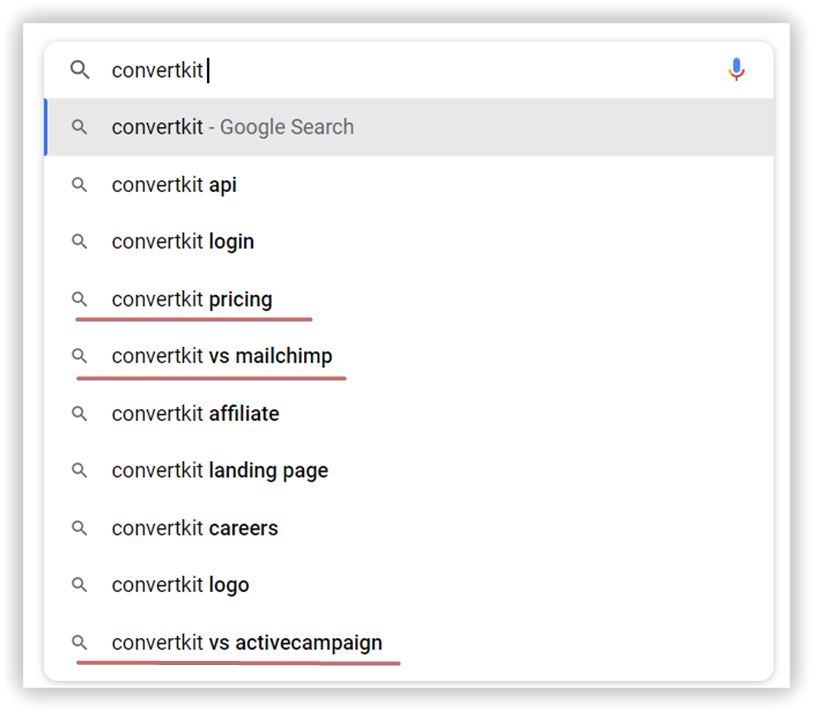Start Exploring Keyword Ideas
Use Serpstat to find the best keywords for your website
Bottom of the Funnel Content: How to Create Conversion-Focused SEO Content

This post will detail how to create the bottom of the funnel content that converts and ranks high on search engines like Google.
Know Your Customers Pain Points
Find Bottom of Funnel Keywords
SERP Analysis
Choose your BoFu Content Format and Angle
Write Insightful Content
Create Super Clear Call to Actions
Don’t Forget About Onpage SEO Best Practices
Great BoFU Content Convert Readers Into Customers
What Is Bottom-Of-The-Funnel Content?

- Case studies
- Testimonials
- X Brand alternatives
- Competitor comparison pages
- Webinars
- Product demo
- Pricing pages
Follow these steps to create highly converting BoFu content that ranks on the first page of Google.
Know Your Customers Pain Points
Spot your competitors' weaknesses
Say, for example, you have started an online accounting software. Your big rivals are QuickBooks Online, FreshBooks, and Zoho Books.
Head over to software review websites like G2. Then search for your biggest competitor, in this case, Zoho Books.
Then pay attention to the things customers are not happy with while using the software. By doing so, you'll collect small golden nuggets of ideas of who your ideal buyer is and what they're looking for.


Use customer surveys
In your surveys, you can ask them questions like:
- Why did you decide to buy our product?
- What's the main benefit you receive from our product/service?
- Have you tried similar products?
- What was your experience using the products?
- What feature/option could we add to make your experience better?
Do customer interviews
The responses you'll get will help your product position and, more importantly, help you create content that directly speaks to similar customers.
Find Bottom of Funnel Keywords
Basically, high-volume keywords have no purchase intent.
Think about it, when was the last time you googled a "what is X" or "How to X" topic that led you to make a purchase? I bet none. Why? Because at this stage, you're not ready to buy. You are learning.
However, when you search for information using specific branded keywords such as "Serpstat vs. Ubersuggest," you are more likely to buy or sign up for either tool's free trials.
Why? Because at this stage, you know what SEO is, its importance to your business, and why you need an SEO tool. And in this case, you're evaluating your options to see which product matches your needs and budget.
The question is, how do you find the bottom of the funnel keywords?
Using Buying Intent Queries
For example, say you created an SEO tool like Serpstat. What kind of content related to Serpstat will convince readers to buy?
Is it a topic like "SEO guide for beginners"? Well, not really. That's because most of the users with buying intent will be passed this stage.
And if you hop the keyphrase to the Serpstat keyword research tool, you'll realize that the keyword and its related terms don't have a high CPC.


Using BoFU Keywords Modifiers
In finding the bottom of the funnel keywords, you can append a keywords modifier to indicate the action users want.
For instance, a person looking to buy hosting services will use keyword variations such as “cheap web hosting” and “buy web hosting services.” And a person evaluating options will use a keyword like “best Bluehost alternatives.”
Take a look at the illustration below and learn how to use modifiers to find the bottom of the funnel keywords.

The good thing about these suggestions is that they are phrases that actual users search on Google. Just hop into the Google search bar and enter your query but don’t hit the enter button.
For instance, say you’re the head of content marketing of a brand like ConvertKit. If you plug in your brand name followed by vs. ( ConvertKit vs), you’ll see potential BoFU keywords used by your consumers.


SERP Analysis
SERP analysis allows you to understand what's expected of your BoFU content for it to rank on the first page of Google. Specifically, you'll discover:
- What themes and topics are being discussed in the content
- What's the expected length of those pieces
- The overall intention of a person searching for the query
- What to do to improve your piece
- The overall content structure of each content
For example, say you've just created a lead generation tool competing with tools like OptinMonster.
Most probably, your first bottom of funnel content idea would be "Best OptinMonster Alternative."
When you do SERP, one thing you'll notice right off the bat is that the posts are listicles.

- Readers who are not happy with OptinMonster and are looking for alternatives
- Users evaluating different lead generation tools because OptinMonster does not offer a free trial
- Users wanting a cheaper alternative offering more features
- Users who want simple but robust lead generation tools
Keeping this in mind, you'll have tackled significant steps of creating your piece.
From our analysis, we noticed that some of these top-ranking pages employ some top of the funnel methodologies in the BoFu content.
For example, if you look at this post by Astra, you'll notice that they've included topics like "what is lead generation" and "why email marketing is so powerful." These sections are not helpful at all to a reader who's ready to convert. You know why you need a lead generation tool. You don't need an explanation for that.
With such topics, it indicates how less you understand your audience. The goal is to appear as an industry expert, not a typical beginner trying to jolt down an article to convince a buyer to convert.
Instead of focusing on such irrelevant topics, why don't you introduce your audience by showing underperforming features that may make them forego your competitor and choose you.
Choose your BoFu Content Format and Angle
The bottom of the funnel comes with different content formats. But not all content forms can be a great deal to create a piece that ranks. Of course, you won't expect your user testimonials and even case studies to rank high on the first page of Google.
However, some bottom of the funnel content formats like "your brand vs. competitor" or "X brand alternatives" have a higher possibility of ranking. That's because they contain the keywords that your customers are actively using.
After choosing the content format, structure your content. By this, I mean using formatting such as headers and bullet points to cover relevant subtopics needed for your content to rank.
The last thing is finding a content angle to communicate your brand's unique value proposition.
When a user evaluates a solution, they want to know what product is right for them. Sometimes it's difficult for them to tell how different a particular product is from your competitors, and it's your job to show how different it is through positioning.
I love how a company like Cloudways communicates its value proposition for you to see how different they are from their competitor. Look at this post that ranks for the keyword "Best Kinsta alternative."

Write Insightful Content
Even Google launched an update to scrape off websites creating content for ranking. To cite one of the requirements, Google says you need to create content demonstrating first-hand expertise and a depth of knowledge.
This is no different for the bottom of funnel content. Thin content can cost you a lot of customers. Readers are getting smarter nowadays and will quickly spot a high-level fluff piece a mile away.
In creating BoFU content that ranks on Google and converts, you need to show high-level experience. You need to clearly show industry expertise to craft a masterpiece that weaves in and sells your product.
The more you write something that resonates with them, the more it's like captivating them to make a purchasing decision.
Create Super Clear Call to Actions
Because, let's face it, the bottom of the funnel content is tailored to persuade readers to convert.
You don't want your readers to finish reading your content and wonder, "Okay, what should I do then?" Instead, you want to direct them to the following action that will lead them to their next buying process.
For example, in their CrazyEgg vs. Hotjar comparison, Hotjar doesn't leave you there to figure out what you need to do next. Instead, they convince you to take action and try out their product.

Don’t Forget About Onpage SEO Best Practices
Instead, you want to ensure that search engines can easily understand your content.
Here's how to optimize your bottom of the funnel content for search engines.
Strategically Use Keywords In Your Content
Never jeopardize your reader's capacity to be engaged, educated, and enlightened by your content to have keywords included multiple times in your content.
But does it mean there's no better way to include keywords in your content? Not really.
Here's how you use keywords naturally in your content.
The title tag
Your blog's title, aka headline, is the first step both search engines use to understand the relevance of your content. Make sure to include your focus keyword in your headline.
Your introduction
Google uses your intro to get the overall picture of your content. From a reader's perspective, the first 100-200 words of an article are often where you establish the context for what will be covered. Because most readers would only read on if the opening is strong, it makes sense that including a keyword in your opening paragraph can help with your SEO ranking.
Meta description
Meta descriptions are often overlooked but hey, hear from us. Although they have no impact on your rankings, they are a pitch that convinces readers to click on your content on SERP. Adding your keyword here helps readers filter through results and choose the piece that perfectly matches their needs.
Use Keywords in Your Article Headings
When it comes to SEO, headlines are significant. That's because Google uses HTML elements to designate H1, H2, and H3 title tags to better understand your content.
Your content headlines are a perfect opportunity to rank for multiple keywords in your content. In this case, I would recommend adding long-tail keywords into your headings.
Use Visuals
In creating SEO-optimized bottom of funnel content, visuals allow your audience to understand your product better and persuade them to take action.
In that case, consider using a ton of multimedia in your content. From screenshots to videos, don't be afraid to add them to your content.
Great BoFU Content Convert Readers Into Customers
At this phase, your customers are ready to convert. What they want is a nudge and extra assurance to take action. Creating content that offers them value will push them to convert.
Speed up your search marketing growth with Serpstat!
Keyword and backlink opportunities, competitors' online strategy, daily rankings and SEO-related issues.
A pack of tools for reducing your time on SEO tasks.
Discover More SEO Tools
Text Analysis Tool
Unlock the power of your text data with our advanced Text Analytics Tools
AI Content Detection
Ai Content Checker – realize if the text is AI-generated
AI Text Generator
Try our AI Content Writer tool and streamline your content creation process
AI Content Tools
AI Content Marketing Tools – simplify and optimize the content creation process
Recommended posts
Cases, life hacks, researches, and useful articles
Don’t you have time to follow the news? No worries! Our editor will choose articles that will definitely help you with your work. Join our cozy community :)
By clicking the button, you agree to our privacy policy.

